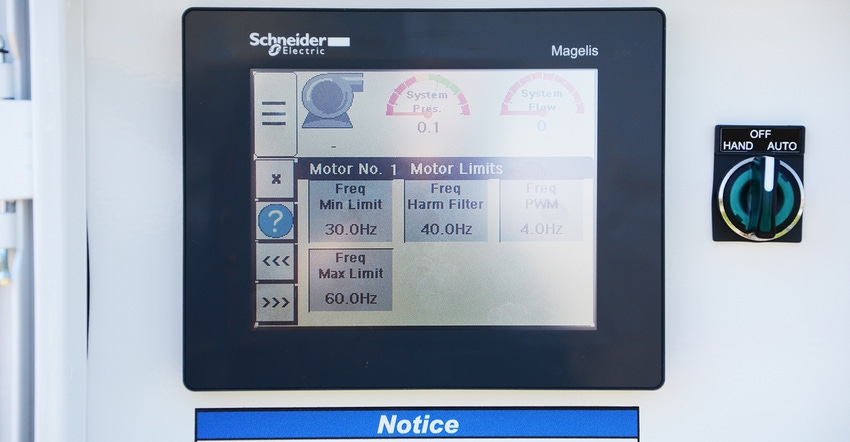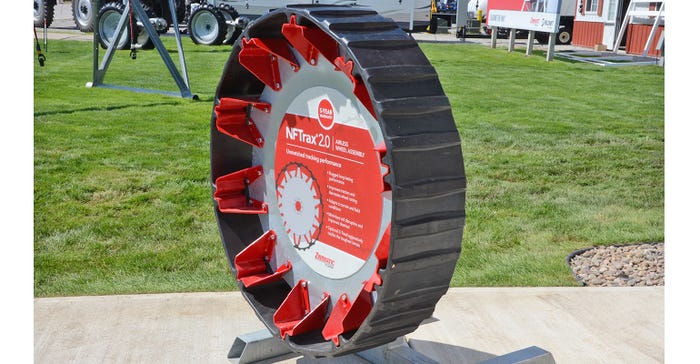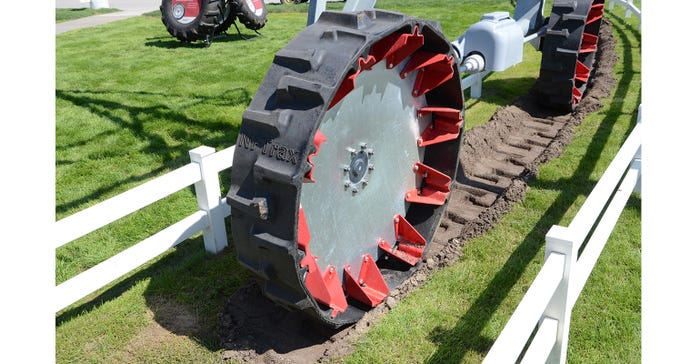September 26, 2018

Leveraging technology for irrigation can come in many forms. Lindsay Corp. offered its share of new products at the fall farm shows ranging from new features for its FieldNet Advisor system to an enhancement for the Zimmatic Variable Frequency Drives. There’s even an evolution to the company’s airless wheel tech — NFTrax.
FieldNet has been available for several years and pulls together a range of information and data for irrigators into a single dashboard. This year, the company has upgraded the software and tech further to provide growers an increased level of customization and mobility, and more precision control of water use.
Brian Magnusson, vice president, technology and innovation, explains that FieldNet and its turnkey scheduling feature, FieldNet Advisor, pull together a range of information into the system. “We’re connected to weather stations, soil moisture probes, crop growth information and other systems to help growers make watering decisions,” he says. “This is an all-in-one platform for managing a farm’s irrigation system.”
The key is the connectivity FieldNet Advisor has to various data sources and sensor tools. The company links with the DTN Weather Station network, and Magnusson says the company is evolving that choice to include access to the Farmers Edge network, too. “We can help farmers make irrigation decisions based on in-field plant data,” he says. “To continue that, we’ll be creating more partnerships to gather information.”
That’s important as more sensor systems come online, but Magnusson says the company isn’t rushing into new partnerships. The key is to work with providers and make sure the data captured can be used.
The upgraded software for water decision-making, FieldNet Advisor, provides automated irrigation recommendations and scheduling; it’s now available to growers in 17 countries and can be used on more than 20 different crops.
The software on FieldNet has seen continued upgrades and updates. Magnusson notes that in the past year, the company has added 70 new features that have been made available to owners for no added cost.

EVOLVING A SYSTEM: NFTrax 2.0 features a widened wing design for supporting the track — you can see it in red. This better distributes weight and supports the track in action.

Upgrading technology
Variable-frequency drives have been used in irrigation for more than 20 years. The technology allows for improved energy efficiency for electric pumps used for moving water. Zimmatic has launched an upgraded VFD that will be easier to use for growers.
“We wanted a product that was easier to use,” says Wade Sikkink, director, global product management. “We have a new easy-to-use, 5.7-inch color screen on our panel.”
This is a touch screen, but the biggest change is the information you can see. This system works with the English language, rather than with codes a farmer has to look up to figure out how to set a pump. The system was designed with pivot irrigation in mind.
And the system can be remotely managed with built-in integration to Lindsay’s FieldNet remote monitoring and control tool.
“The system was designed so a user would press a few keys and know how to set it up; then they would be off and running,” Sikkink says.

MORE TRACTION: On slops, or in sticky, clay soil, this more aggressive Z-Tread offers the traction some farmers will need. The omnidirectional base track design works for most situations, and the Z-Tread is for special problem areas where traction is a challenge.

A traction evolution
Four years ago, Lindsay launched NFTrax, an airless wheel design that can’t go flat and works to keep ruts to a minimum. The company has sold thousands of the original model, according to Christopher Higgins, Zimmatic global product manager. “We’re launching the next version of the system, NFTrax 2.0,” he says. “We’ve redesigned the drive points to increase their surface area. In fact, we’ve increased the area four-fold, and that’s a good thing.”
The standard belt is a heavy-duty vulcanized belt with a steel cable core that’s tensioned over the newly designed, winged drive points to apply even pressure across the drive belt. “We get more traction, and we more evenly distribute the weight of the pivot,” he says.
The omnidirectional belt is standard for the NFTrax, but the company is also offering a new tread design —the NFTrax Z-Tread.
“This tread offers a high-low alternating pattern that’s more like an R1 tractor tire,” Higgins says. “We’re recommending this only if needed to dig deeper and provide added traction.”
There are situations where pivots can see slippage when moving through a field in specific soil conditions. “It’s an aggressive tread design and can provide added traction on slopes, low spots or areas where you have slick soils,” he adds.
The NFTrax has been out four years, and the company is seeing solid performance. Higgins notes that there’s a five-year, 7,500-hour warranty on NFTrax, and he’s seen good performance in a variety of conditions. In four years, on one Idaho farm, Higgins points out that the producer has put 4,000 hours on his NFTrax, and they show little wear. “And that’s in more volcanic soil that wears on tires,” he notes.
You can learn more about these products at zimmatic.com.
The rise of the ‘internet of things’
Talking with Brian Magnusson, vice president, technology and innovation, and Wade Sikkink, director, global product management, both with Lindsay, brings up a range of topics. It’s their job to track and deploy new technology for the company. During a talk with Farm Progress, Sikkink discussed the phenomenon of the “internet of things.”
“Most people think it’s about their refrigerator,” he smiles, referring to connected refrigerators that many farmers may have seen on television that allow you to shop for groceries, or alert users to other issues because they’re connected to the web. “Three years ago, we bought a company called Elecsys that has been working in the ‘IoT’ space for 20-plus years.”
This gives the company added horsepower as IoT products move into agriculture, but Magnusson brings up an interesting thought: Anything connected to the cloud is part of the family of the internet of things. So often, the perception is that these products are small sensors, but “an irrigation pivot isn’t a small thing, and it’s connected to the cloud and is an IoT device,” he notes.
Looking ahead, Magnusson notes that the rise of IoT is an opportunity for farmers to gather more information, but how that information is used will matter. “A weather station will tell a farmer what’s happening at that moment. You need systems that can calculate evapotranspiration and better determine how water is used in that field,” he notes. “Integrating that information is something we have to work on.”
Sikkink adds that it’s how you use the data that matters. He points to the talk of 5-bale cotton in the Delta. That’s great news for that part of the country, but what does it mean to a farmer raising cotton in the Southwest? “The farmer in the Southwest doesn’t care about 5-bale cotton when he sees 3-bale cotton as a high mark based on water and weather in the region,” Sikkink says. “The key is using the data that you collect to help them make more money on the 3-bale cotton they can raise.”
And that concept — using big data to help boost return on investment — is a goal for the company.
About the Author(s)
You May Also Like






